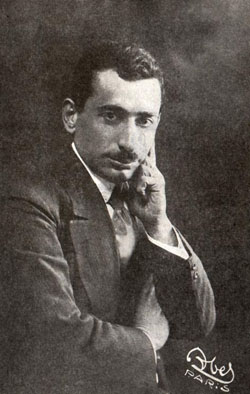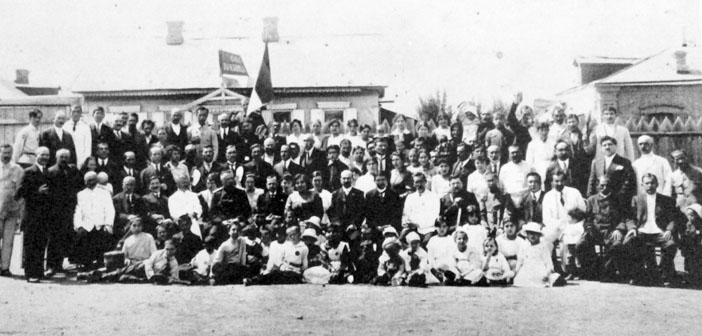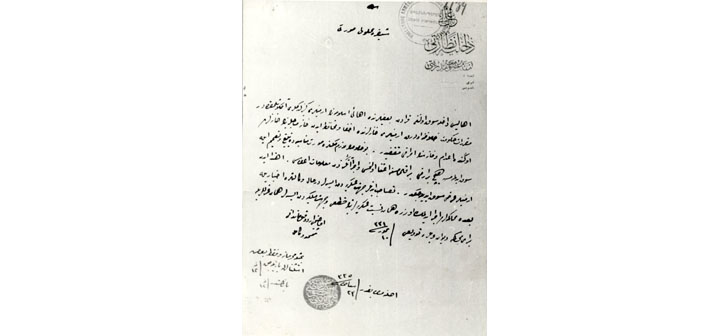Prof. Dr. Taner Akçam, in his recent book, published the memoirs of Naim Bey, who played an important part in the historiography of the Armenian Genocide and whose existence had been denied. With this book, Prof. Akçam responded the claims and broke a new ground in the historiography of the Armenian Genocide.
Memoirs of Naim Bey, who played an important part in
the historiography of the Armenian Genocide, had been denied up to
now. Denialists have been claiming that there was no Ottoman officer
named Naim and the encryption codes of the documents in his memoirs
don't match the encryption techniques in Ottoman Empire. Prof. Dr.
Taner Akçam from Clark University Strassler Center for Holocaust and
Genocide Studies published the memoirs of Naim Bey in his recent book
and responded the claims and broke a new ground in the historiography
of the Armenian Genocide. The book titled as ‘Naim Efendi’nin
Hatıratı ve Talat Paşa Telgrafları’ (Memoir of Naim Efendi and
Talat Pasha Telegrams) is published in Turkish with documents. We
talked to Prof. Dr. Taner Akçam on the occasion of the launching of
his book.
We know that Aram Andonyan wrote about Naim Bey's documents. How are these documents treated in Andonyan's book?
Andonyan compiled Memories of Naim Efendi and Talat Pasha Telegrams in a book titled as “Büyük Cinayet” (the Great Crime). It was published in 1921 in Armenian. Then, it was translated to French and also published in English as a summary titled as “the Memoirs of Naim Bey”, which was a very bad translation. “The Great Crime” includes a memoir belonging to an Ottoman officer named Naim Efendi and some confidential documents provided by him. Andonyan said that he bought this memoir and documents. In fact, it is not a memoir as we know. Naim Efendi copied around 50 Ottoman document by hand and added the things that he remember and know. Naim Efendi also gave around 20 original documents to Andonyan. Images of 14 documents were published in the Armenian version of the book. From a note of Andonyan, we know that this exchange of documents happened on November 1918. I published the document of this exchange in my book.
What is written in those telegrams?
In some telegrams allegedly written by Talat Pasha, we see that there are direct orders for killing Armenians. For instance, in a telegram dated September 22, 1915, Talat Pasha wrote as the following: “For Armenians, some rights, such as living and working within the borders of Turkey, are abolished. In this regard, the government takes the whole responsibility and orders getting rid of them all, including the infants.”
In a telegram, which is dated September 29, 1915 and was sent to Aleppo Province, he wrote: “Previously, it was informed that the government, by the order of the Union, decided to annihilate all Armenians… All of them, including women, children and handicapped ones, will be wiped off without giving in the conscientious feelings and regardless of how terrible the measures of annihilation would be.”
I should note that these telegrams, which were published in Andonyon’s book as images, consist of numbers. The encryption of the documents are found in the memoirs of Naim Efendi.
It has been claimed that these telegrams are not real, right?
The denial concerning the telegrams stems from a book by Şinasi Orel and Süreyya Yuca titled as “The Truth behind the telegrams attributed to Talat Pasha by Armenians”. In this book, Orel and Yuca claimed that the memoirs and documents that were published by Andonian are fake.
What was the basis of their claim?
Orel and Yuca have three main claims as their basis: (1) There was no Ottoman officer named Naim, (2) A non-existent man cannot have a memoir, and (3) All the telegrams, including the ones attributed to Talat Pasha are fake. All of these were made up by Andonyan and Armenians. They put twelve evidences for the third claim. The most important evidences are: the dates of the documents are not accurate; the numbers written on the documents don’t match with the numbers that were recorded to the book of Ministry of Interior; the signatures, particularly the signature of Governor Mustafa Abdülhalik are fake; they were written on ruled paper, which hadn’t been used by Ottoman bureaucracy; the documents encrypted by 2 and 3-digit numbers are completely fake, because 4 and 5 digit numbers had been used for encryption in those times.
The claims of Orel and Yuca seemed really strong and assertive. The sources used by the authors, for instance Ottoman Archives of the Prime Minister's Office and the archive of Turkish Armed Forces (ATASE) weren’t accessible back then. The Ottoman archive was open of course, but the documents belonging that period were not organized and couldn’t be found. ATASE was closed; it can be said that it is still closed.
It should be noted that Andonyan took the documents that he got from Naim Efendi to Paris and trusted them with Boğos Nubar Paşa Library. Probably, they got lost after 1950. Today, the whereabouts of these documents is unknown.
Until the publication of Oral and Yuca’s book, Andonyan’s book and its content -memoirs of Naim Efendi and Talat Pasha telegrams- had been used as an important source. Then, people stopped using it on the ground that it contains fake and unreliable information. More importantly, Orel and Yuca accused Aram Andonyan and Armenains with forging documents and committing a kind of “murder”. In the later years, the book became one of the most important means of hate speech against Armenians. It has been used for an intense defamation and denigration campaign.
"There is also a very interesting detail. One of the
Ottoman documents proving the existence of Naim Efendi was released
by Turkish Armed Forces. Turkish Armed Forces ATASE archive published
a document containing Naim Efendi's original signature in book on
Armenian question. Probably, they didn't notice it. This document can
be seen in my book."In your book, have you written that Orel and Yuca are wrong in their claims and that the memoir and telegrams are real?
Yes, Orel and Yuca's claims concerning Naim Efendi and his memoirs are definitely wrong. During my research, I found out new information and documents which are utterly important. Let me summarize them: (1) There is an Ottoman officer called Naim Efendi. There are original Ottoman documents showing that and I put them on my book. There is also a very interesting detail. One of the Ottoman documents proving the existence of Naim Efendi was released by Turkish Armed Forces. Turkish Armed Forces ATASE archive published a document containing Naim Efendi's original signature in book on Armenian question. Probably, they didn't notice it. This document can be seen in my book. (2) There is a memoir belonging to Naim Efendi; I have the films of this memoir which he wrote by hand in Ottoman Turkish. I published the complete memoir. On this point, there is an additional important information: Andonyan hadn't published the entire memoir. He used a part of it. In my book, there are some part of the memoir that will be read for the first time. Interestingly, some parts of the memoir published by Andonyan are missing. This means that some parts that Andonyan published are missing in the memoir I have. I explain the reasons in my book. The missing parts must be in ATASE archive. (3) The memoir is real and the information it provides is true. It is possible to find the documents about the incidents and people he wrote about in the Ottoman archive. For instance, Naim Efendi, in the part of the memoir that I published for the first time, names some Armenian exiles and writes: “We received an order from Istanbul about these people; they said keep them in Aleppo, don't sent them away. However, the governor sent them to their demise.” Naim Efendi doesn't provide a document concerning this order, he only reports what he remembers. I found this telegram in the Ottoman archive. I carried out studies on almost 10 cases like this and I found plenty of documents in the archive about the incidents that Naim Bey wrote about. This means that the information included in the memoir is true. (4) Oral and Yuca's main claims for proving that Talat Pasha telegrams are fake, like the ruled paper and encryption techniques, are wrong. It is all made up. Thus, the telegrams must be considered as genuine, until Encryption Key Books are released. Only these books can reveal whether they are fake or not.
 What is this issue about “ruled paper”?
What is this issue about “ruled paper”?
In Andonyan's book, there is an image of a telegram dated March 20, 1916, which was sent to Ministry of Foreign Affairs and encrypted with 2-digit numbers. It was written on a ruled paper. Orel and Yuca uses this for proving that the document is fake, since, according to them, Ottoman bureaucracy had not been using ruled paper.
This is non-sense, because Ottoman bureaucracy had been using ruled paper in those time and there are a lot of documents in the Ottoman archive showing that Ministry of Foreign Affairs had ordered ruled paper for using in different departments of the ministry. The most important one is a notice sent to all regions on November12, 1913. In this notice, it was ordered the telegrams, especially the encrypted ones, to be written on ruled paper. This means that the truth is on the contrary to what Orel and Yuca say; the ruled paper indicates that the telegrams are genuine.
Can you explain what you mean by encryption techniques?
Ottoman government was sending telegrams containing orders by encrypting them with different number combinations. There are groups of numbers consisting of 2, 3, 4 and 5 digit numbers. The telegrams that Naim Efendi sold to Andoyan are encrypted with 2 and 3 digit numbers. Orel and Yuca claimed that Ottoman government, during the war, had been using only 4 and 5 digit numbers for encryption and thus Naim Efendi's telegrams are fake. Furthermore, according to Yuca and Orel, an encryption technique was changed after at most 6 months; during a certain period of time, only a single group of number was used. For instance, according to them, between August 25 and December 11, 1915 only 5 digit numbers were used and around March 1916, only 4 digit numbers were used for encryption. None of these claims are true.
I looked at more than 20,000 documents in the Ottoman archive belonging to those periods. Between 1914 and 1918; 2, 3, 4, and 5 digit numbers had been randomly used. So, authors' claim about the encryption technique is non-sense.
Well, this proves that Orel and Yuca's claims are not true, but does it also prove that Talat Pasha telegrams are real?
I clearly show that the encryption of Naim Efendi's telegrams are conformed with Ottoman encryption techniques. In the archive, I found telegrams that were sent during the same period; they were also encrypted by 2 and 3 digit numbers. You can see them in my book. Of course, one can ask: Isn't it possible that Naim Efendi's telegrams are fake, though they are conformed with the encryption technique of the period? How can we know for sure? It is really easy: just release the Encryption Key Books belonging to that period.
Ottoman government issued a key book for each encryption technique and sent them to the regions. There are correspondences about this. The authorities in the regions were using these books for deciphering the encrypted telegrams from Istanbul. We know that those key books are in the archive now. For instance, I have such a book dated 1914, which contains the key for 3 digit encryption. However, the books of 1915 and 1917 are denied to researchers. The ones who claim that Naim Efendi's document are fake can release these books and put an end to the discussion. Then we can understand that they are fake.
Until these books are released, we should take the documents in the book as original. For the claims for forgery are wrong. This might be one of the reasons why the key books are not given to the researchers. Maybe the book will show the genuineness of the documents and they are afraid of that. If you believe that the documents are fake, just release the key books...
After your book, could there be changes in historiography of the genocide?
The claims that there was no Ottoman named Naim Efendi, there is no memoir belonging to Naim Efendi and Talat Pasha telegrams are fake have been among the most important grounds for denying what happened in 1915. There is not doubt that the book won't end denialism, but the denialist people have to find new lies. However, we should keep in mind that the denial of 1915 doesn't caused by insufficiency of documents. Denying the past is a political choice. So, no matter how many documents about the historical facts you show, the denialist will continue to deny. This is an endless game...
Thus, I think that the advocates of the official state theses will get their own way. However, this book shatters the foundation of the wall of lies.
My expectation is different. I expect an apology to Armenian people. The ones who have been inciting hatred against Armenians, who have been insulting and accusing them by using the memoir and telegrams should apologize. It is a rightful demand.
As I have shown in my book, neither Andonyan nor any other Armenian had distorted anything. Andonyan had only published what was given to him. Thus, the ones who committed hate crime since the book was published in 1983 should openly apologize. Personally, I won't discuss this issue with anyone who doesn't apologize.





